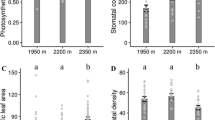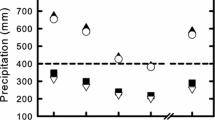Abstract
Variation in mating system traits can have important consequences for plant populations by affecting reproductive assurance, the expression of inbreeding depression, and the colonization of and persistence in new or altered habitats. Environmental stressors, such as drought, have been hypothesized to induce higher rates of self-fertilization, yet this hypothesis has rarely been tested. Here we measure the response of two sister species of self-compatible annual herbs from contrasting habitats, Clarkia breweri and C. concinna, to an experimentally imposed greenhouse drought treatment. We find that the species differ in their baseline per-flower autogamy rates and the degree of spatial and temporal separation of male and female function within their flowers. Both species show a reduction in temporal separation of anthesis and stigma receptivity with the drought treatment. However, the species from the more mesic habitat, C. concinna, increases its low autogamy rate under drought conditions, whereas the species from the more xeric habitat, C. breweri, decreases its high autogamy rate under drought conditions. Neither species showed a response to drought in flower size or anther-stigma distance. Our results demonstrate that the induction of selfing under environmental stress cannot be assumed and that, in this case, the developmental timing of flower maturation is more plastic than floral morphology.



Similar content being viewed by others
References
Allen GA, Gottlieb LD, Ford VS (1991) Electrophoretic evidence for the independent origins of 2 self-pollinating subspecies of Clarkia concinna (Onagraceae). Can J Bot-Revue Canadienne De Botanique 69:2299–2301
Ashman TL, Schoen DJ (1997) The cost of floral longevity in Clarkia tembloriensis: an experimental investigation. Evolut Ecol 11:289–300
Baker HG (1955) Self-compatibility and establishment after “long-distance” dispersal. Evolution 9:347–348
Barrett SCH, Charlesworth D (1991) Effects of a change in the level of inbreeding on the genetic load. Nature 352:522–524
Bolmgren K, Cowan PD (2008) Time— size tradeoffs: a phylogenetic comparative study of flowering time, plant height and seed mass in a north-temperate flora. Oikos 117:424–429
Bradshaw AD (1965) Evolutionary significance of phenotypic plasticity in plants. Adv Genet 13:115–155
Campbell DR, Waser NM, Melendez-Ackerman EJ (1997) Analyzing pollinator-mediated selection in a plant hybrid zone: hummingbird visitation patterns on three spatial scales. Am Nat 149:295–315
Charlesworth B (1992) Evolutionary rates in partially self-fertilizing species. Am Nat 140:126–148
Charlesworth D, Charlesworth B (1987) Inbreeding depression and its evolutionary consequences. Ann Rev Ecol Syst 18:237–268
Cohen D, Dukas R (1990) The optimal number of female flowers and the fruits-to-flowers ratio in plants under pollination and resource limitation. Am Nat 135:218–241
Delesalle VA, Mazer SJ, Paz H (2008) Temporal variation in the pollen: ovule ratios of Clarkia (Onagraceae) taxa with contrasting mating systems: field populations. J Evol Biol 21:310–323
Dudley LS, Mazer SJ, Galusky P (2007) The joint evolution of mating system, floral traits and life history in Clarkia (Onagraceae): genetic constraints vs. independent evolution. J Evol Biol 20:2200–2218
Eckhart VM, Singh I, Louthan AM et al (2010) Plant-soil water relations and the species border of Clarkia xantiana ssp. xantiana (Onagraceae). Int J Plant Sci 171:749–760
Eckhart VM, Geber MA, Morris WF et al (2011) The geography of demography: long-term demographic studies and species distribution models reveal a species border limited by adaptation. Am Nat 178:S26–S43
Fausto JA, Eckhart VM, Geber MA (2001) Reproductive assurance and the evolutionary ecology of self-pollination in Clarkia xantiana (Onagraceae). Am J Bot 88:1794–1800
Fishman L, Wyatt R (1999) Pollinator-mediated competition, reproductive character displacement, and the evolution of selfing in Arenaria uniflora (Caryophyllaceae). Evolution 53:1723–1733
Goldberg EE, Kohn JR, Lande R et al (2010) Species selection maintains self-incompatibility. Science 330:493–495
Goodwillie C, Kalisz S, Eckert CG (2005) The evolutionary enigma of mixed mating systems in plants: occurrence, theoretical explanations, and empirical evidence. In Annual Review of Ecology Evolution and Systematics, Annual Review of Ecology Evolution and Systematics, pp 47–79
Gottlieb LD, Ford VS (1996) Phylogenetic relationships among the sections of Clarkia (Onagraceae) inferred from the nucleotide sequences of PgiC. Syst Bot 21:45–62
Gottlieb LD, Weeden NF (1979) Gene duplication and phylogeny in Clarkia. Evolution 33:1024–1039
Grant V (1981) Plant speciation, 2nd edn. Columbia University Press, New York
Groom MJ (1998) Allee effects limit population viability of an annual plant. Am Nat 151:487–496
Groom MJ, Preuninger TE (2000) Inbreeding depression is not diminished in isolated subpopulations of Clarkia concinna concinna (Onagraceae). Evol Ecol 14:155–180
Holtsford TP, Ellstrand NC (1992) Genetic and environmental variation in floral traits affecting outcrossing rate in Clarkia tembloriensis (Onagraceae). Evolution 46:216–225
Kalisz S, Vogler D, Fails B et al (1999) The mechanism of delayed selfing in Collinsia verna (Scrophulariaceae). Am J Bot 86:1239–1247
Kalisz S, Vogler DW, Hanley KM (2004) Context-dependent autonomous self-fertilization yields reproductive assurance and mixed mating. Nature 430:884–887
Kalisz S, Randle A, Chaiffetz D et al (2012) Dichogamy correlates with outcrossing rate and defines the selfing syndrome in the mixed-mating genus Collinsia. Ann Bot 109:571–582
Karron JD, Ivey CT, Mitchell RJ et al (2012) New perspectives on the evolution of plant mating systems. Ann Bot 109:493–503
Kulbaba MW, Worley AC (2008) Floral design in Polemonium brandegei (Polemoniaceae): genetic and phenotypic variation under hawkmoth and hummingbird pollination. Int J Plant Sci 169:509–522
Lande R, Schemske DW (1985) The evolution of self-fertilization and inbreeding depression in plants 1. Evolution 39:24–40
Levin DA (2010) Environment-enhanced self-fertilization: implications for niche shifts in adjacent populations. J Ecol 98:1276–1283
Levin DA (2012) Mating system shifts on the trailing edge. Ann Bot 109:613–620
Lewis H (1955) The genus Clarkia, 20(4). University of California Press, Berkeley and Los Angeles
Lewis H (1962) Catastrophic selection as a factor in speciation. Evolution 16:257–271
Lewis H (1973) Origin of diploid neospecies in Clarkia. Am Nat 107:161–170
Lewis H, Lewis ME (1955) The genus Clarkia, vol 20, no. 4. University of California Press, Berkeley
Lloyd DG (1979) Some reproductive factors affecting the selection of self-fertilization in plants. Am Nat 113:67–79
Lloyd DG (1992) Self-fertilization and cross-fertilization in plants. II. The selection of self-fertilization. Int J Plant Sci 153:370–380
Lloyd DG, Webb CJ (1986) The avoidance of interference between the presentation of pollen and stigmas in angiosperms. I Dichogamy. NZ J Bot 24:135–162
Lloyd DG, Yates JMA (1982) Intra-sexual selection and the segregation of pollen and stigmas in hermaphrodite plants, exemplified by Wahlenbergia albomarginata (Campanulaceae). Evolution 36:903–913
MacSwain J, Raven PH, Thorp R (1973) Comparative behavior of bees and Onagraceae. IV. Clarkia bees of the western United States. Univ Calif Publ Entomol 70:1–80
Martin NH, Willis JH (2007) Ecological divergence associated with mating system causes nearly complete reproductive isolation between sympatric Mimulus species. Evolution 61:68–82
Mazer SJ, Paz H, Bell MD (2004) Life history, floral development and mating system in Clarkia xantiana (Onagraceae): do floral and whole-plant rates of development evolve independently. Am J Bot 91:2041–2050
Mazer SJ, Dudley LS, Hove AA et al (2010) Physiological performance in Clarkia sister taxa with contrasting mating systems: do early-flowering autogamous taxa avoid water stress relative to their pollinator-dependent counterparts? Int J Plant Sci 171:1029–1047
Moeller DA, Geber MA, Eckhart VM et al (2012) Reduced pollinator service and elevated pollen limitation at the geographic range limit of an annual plant. Ecology 93:1036–1048
Moore DM, Lewis H (1965) The evolution of self-pollination in Clarkia xantiana. Evolution 19:104–114
Morgan M (1993) Fruit to flower ratios and trade-offs in size and number. Evol Ecol 7:219–232
Murren CJ, Dudash MR (2012) Variation in inbreeding depression and plasticity across native and non-native field environments. Ann Bot 109:621–632
Nicotra AB, Atkin OK, Bonser SP et al (2010) Plant phenotypic plasticity in a changing climate. Trends Plant Sci 15:684–692
Runions CJ, Geber MA (2000) Evolution of the self-pollinating flower in Clarkia xantiana (Onagraceae). I. Size and development of floral organs. Am J Bot 87:1439–1451
Sargent RD, Goodwillie C, Kalisz S et al (2007) Phylogenetic evidence for a flower size and number trade-off. Am J Bot 94:2059–2062
Schoen DJ, Lloyd DG (1984) The selection of cleistogamy and heteromorphic diaspores. Biol J Linn Soc 23:303–322
Sime K, Baldwin I (2003) Opportunistic out-crossing in Nicotiana attenuata (Solanaceae), a predominantly self-fertilizing native tobacco. BMC Ecol 3:6
Stebbins GL (1957) Self fertilization and population variability in the higher plants. Am Nat 91:337–354
Stebbins GL (1974) Flowering plants: evolution above the species level. Belknap Press, Cambridge
Steets JA, Ashman TL (2004) Herbivory alters the expression of a mixed-mating system. Am J Bot 91:1046–1051
Steets JA, Wolf DE, Auld JR et al (2007) The role of natural enemies in the expression and evolution of mixed mating in hermaphroditic plants and animals. Evolution 61:2043–2055
Sytsma KJ, Gottlieb LD (1986) Chloroplast DNA Evolution and Phylogenetic-Relationships in Clarkia (Onagraceae). Am J Bot 73:788–799
van Kleunen M, Fischer M (2005) Constraints on the evolution of adaptive phenotypic plasticity in plants. New Phytol 166:49–60
Via S, Gomulkiewicz R, Dejong G et al (1995) Adaptive phenotypic plasticity—consensus and controversy. Trends Ecol & Evol 10:212–217
Vogler DW, Kalisz S (2001) Sex among the flowers: the distribution of plant mating systems. Evolution 55:202–204
Worley AC, Barrett SCH (2000) Evolution of floral display in Eichornia paniculata (Pontideriaceae): direct and correlated responses to selection on flower size and number. Evolution 54:1533–1545
Acknowledgments
We thank J. Velzy and D. Polk for expert plant care, T. Miller for unpublished data, and T. Miller, M. Peterson, and two anonymous reviewers for helpful comments on the manuscript. We dedicate this paper to the memory of Les Gottlieb for his inspiring body of work investigating mechanisms of evolution in Clarkia.
Author information
Authors and Affiliations
Corresponding author
Rights and permissions
About this article
Cite this article
Kay, K.M., Picklum, D.A. Drought alters the expression of mating system traits in two species of Clarkia . Evol Ecol 27, 899–910 (2013). https://doi.org/10.1007/s10682-013-9630-6
Received:
Accepted:
Published:
Issue Date:
DOI: https://doi.org/10.1007/s10682-013-9630-6




